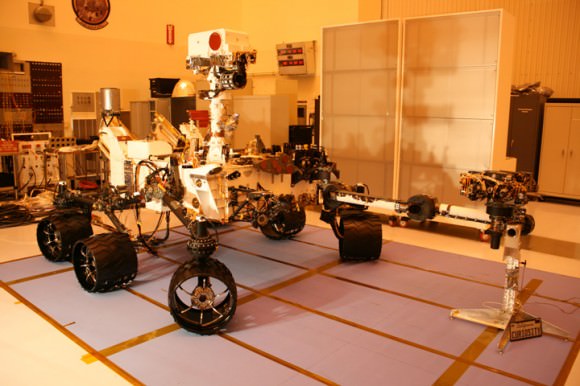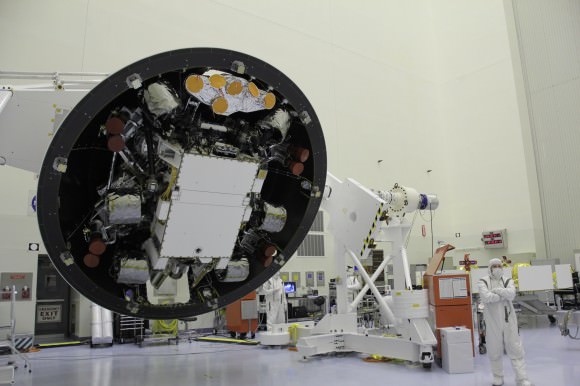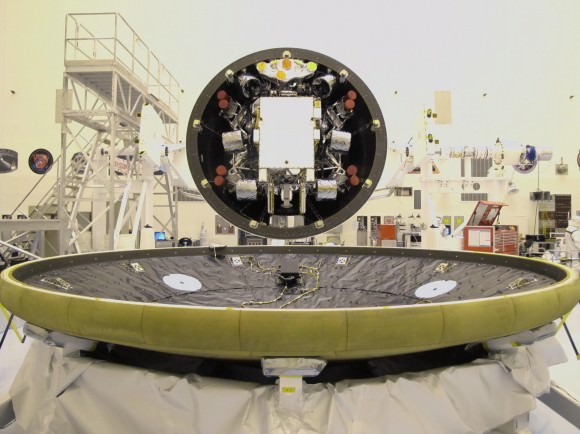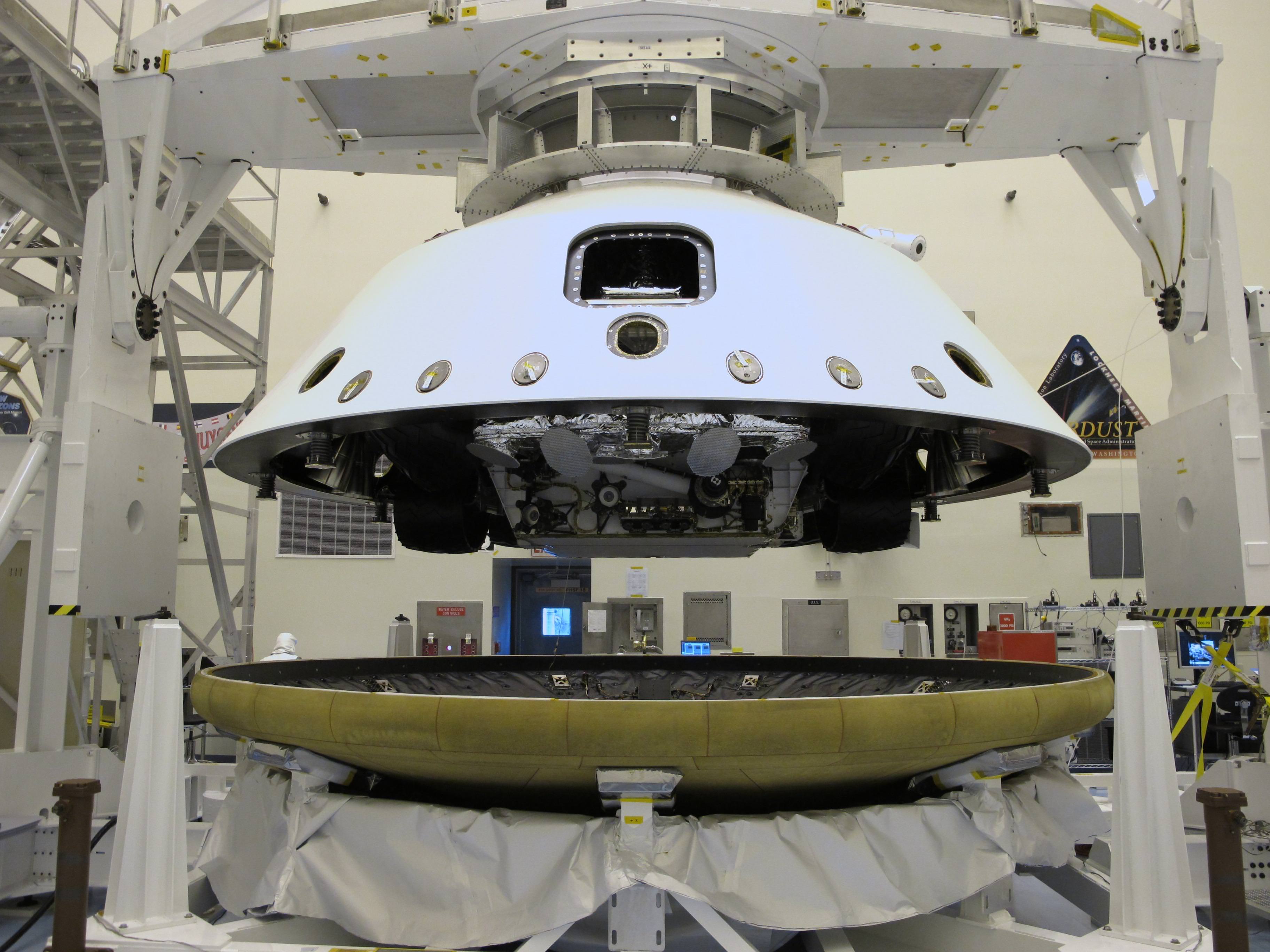[/caption]
With just over 6 weeks to go until the liftoff of Curiosity – NASA’s next Mars rover – prelaunch processing at the Kennedy Space Center (KSC) in Florida is rapidly entering the home stretch. Technicians placed the folded rover inside the complete aeroshell to match the Martian entry configuration components together and conduct preflight testing of the integrated assembly at the Payload Hazardous Servicing Facility at KSC. The aeroshell is comprised of the heat shield and back shell and encapsulates Curiosity during the long voyage to Mars.
The job of the aeroshell is to protect the Curiosity Mars Science Laboratory (MSL) from the intense heat of several thousand degrees F(C) generated by friction as the delicate assemblage smashes into the Martian atmosphere during the terrifying entry and descent to the surface.

The rover itself has been mated to the back shell powered descent vehicle, known as the PDV or sky crane. The rocket powered descent stage (PDV) is designed to maneuver through the Martian atmosphere, slow the descent and safely set Curiosity down onto the surface at a precise location inside the chosen landing site of Gale Crater.
Technicians still have several more weeks of hardware testing and planetary protection checks ahead before NASA’s minivan sized Martian robot is encapsulated inside the aeroshell for the final time.

At the Payload Hazardous Servicing Facility at the Kennedy Space Center in Florida, the "back shell powered descent vehicle" configuration of NASA's Mars Science Laboratory is being rotated for final closeout actions. At this time Curiosity and its rocket-powered descent stage have already been integrated, and are now encapsulated inside the spacecraft's back shell. The configuration of rover integrated with the descent stage is the "powered descent vehicle." The back shell, a protective cover, carries the parachute and several other components used during descent. The yellow disks visible at the top of the configuration are the descent stage's radar antennas that will be used to calculate the rover's descent speed and altitude. Credit: NASA/JPL-Caltech
Another major task still to be completed is mating the aeroshell to the cruise stage and then fueling of the cruise stage, which guides MSL from the Earth to Mars, according to Guy Webster, press spokesman for NASA’s Jet Propulsion Laboratory which manages the MSL project for NASA.
The launch of the $2.5 Billion Curiosity rover atop an Atlas V rocket is slated for Nov. 25, the day after Thanksgiving, and the launch window extends until Dec. 18. Arrival at Gale crater is set for August 2012.
Curiosity is by far the most scientifically advanced surface robotic rover ever sent beyond Earth and will search for environmental conditions that could have been favorable to support Martian microbial life forms if they ever existed in the past or present.

At the Payload Hazardous Servicing Facility at NASA's Kennedy Space Center in Florida, the "back shell powered descent vehicle" configuration, containing NASA's Mars Science Laboratory rover, Curiosity, is being rotated for final closeout actions. The flat, circular object in the foreground of the image is the spacecraft's heat shield. The heat shield and the back shell will together form an encapsulating aeroshell that will protect the rover from the intense heat and friction that will be generated as the flight system descends through the Martian atmosphere.Credit: NASA/JPL-Caltech
Watch for my upcoming report from inside the cleanroom with Curiosity.
Read Ken’s continuing features about Curiosity and Opportunity starting here:
Opportunity spotted Exploring vast Endeavour Crater from Mars Orbit
Twin Towers 9/11 Tribute by Opportunity Mars RoverNASA Robot arrives at ‘New’ Landing Site holding Clues to Ancient Water Flow on Mars
Opportunity Arrives at Huge Martian Crater with Superb Science and Scenic Outlook
Opportunity Snaps Gorgeous Vistas nearing the Foothills of Giant Endeavour Crater
Dramatic New NASA Animation Depicts Next Mars Rover in Action
Opportunity Rover Heads for Spirit Point to Honor Dead Martian Sister; Science Team Tributes


How does a capsule like this “balance” on the wind resistance and avoids tumbling down instead?
The descent is mostly stabilized by gyroscopes. This maintains a constant axis of direction for the descent. To correct for small pertubations which change the orientation of descent there are small thrusters which make corrections.
LC
I remembered this longer video which includes the Entry, Descent and Landing stages staring around 1 min in.
You can see the thrusters working, and just before the 2 min mark you will hear and see (small) explosives eject weights. Those have been adjusting the mass center of the assembly to the brake attitude, and ejecting it will allow for landing attitude. Rocket scientists use everything including old Newton.
I remembered this longer video which includes the Entry, Descent and Landing stages staring around 1 min in.
You can see the thrusters working, and just before the 2 min mark you will hear and see (small) explosives eject weights. Those have been adjusting the mass center of the assembly to the brake attitude, and ejecting it will allow for landing attitude. Rocket scientists use everything including old Newton.